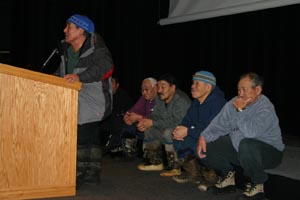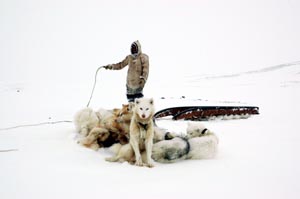Table of Contents
*
F.I.D.O.: Ken Beattie
*
Nunavik Dog Slaughters, Part II
*
Fan Mail
*
In the News
*
Behavior Notebook: Life in the Pack
*
Book Review: Soldiers & Sled Dogs
*
Janice Howls: Preserving Nature's Standard
*
IMHO: Tough Dogs, Tough Owners
Navigating This
Site
Index of articles by subject
Index
of back issues by volume number
Search The
Fan Hitch
Articles
to download and print
Ordering
Ken MacRury's Thesis
Our
comprehensive list of resources
Talk
to The
Fan Hitch
The Fan
Hitch home page
ISDI
home page
Editor's/Publisher's Statement
Editor: Sue Hamilton
Webmaster: Mark Hamilton
The Fan Hitch welcomes your letters, stories, comments and suggestions. The editorial staff reserves the right to edit submissions used for publication.
Contents of The Fan Hitch are protected by international copyright laws. No photo, drawing or text may be reproduced in any form without written consent. Webmasters please note: written consent is necessary before linking this site to yours! Please forward requests to Sue Hamilton, 55 Town Line Rd., Harwinton, Connecticut 06791, USA or mail@thefanhitch.org.
This site is dedicated to the Inuit Dog as well as related Inuit culture and traditions. It is also home to The Fan Hitch, Journal of the Inuit Sled Dog.

After the film premiere of "Echo of the
last howl", Davidee
Niviaxie, an
elder from Umiujaq, talks about how his
dogs were poisoned
by the
RCMP police officer back when the dog
slaughters were
taking place...
Other men are listening, waiting for
their turn to speak...
photo: Isabelle Dubois/Makivik Corp.
Dog Slaughter Inquiry - Update
The April 15, 2005 deadline set by Canada's Parliamentary Standing Committee on Aboriginal Affairs and Northern Development to appoint a judge to initiate a formal inquiry into the slaughter of Inuit Sled Dogs in the 1950s to early 1970s, has passed with no action on it being taken. Although requested, actions as a result of committee voting are not binding, but seldom does the government ignore them. However, regarding the demand for this particular formal inquiry, that is exactly what parliament has done… again.
On April 19th, a new motion was voted on and passed by the committee, again requesting the appointment of a judge to lead a formal investigation and present findings within three months after his or her appointment.
Meanwhile, earlier last month (May), several Canadian news sources reported that the Royal Canadian Mounted Police planned to launch its own investigation. This drew the incredulous replies of Thomas Aliqatuqtuq, president of the Qikiqtani Inuit Association, Makivik Corporation president Pita Aatami, and the Inuit Sled Dog International, all of whom collectively questioned the validity of any conclusions that might be reached by the RCMP as it investigated itself.
RCMP Division Inspector Paul Young said in a May 13 radio interview that he expects to include his inquiry before the end of June, in about seven weeks. A judge appointed as the result of the Standing Committee on Aboriginal Affairs and Northern Development's request for a formal inquiry would take twelve weeks after his or her appointment to submit a report.
Despite the previously reported admission that relevant RCMP records of that era were destroyed, and before the currently planned 'fact finding mission' got underway, Inspector Young had already stated (in a May 10 CBC North interview), "I can tell you that our research as an organization has not shown any government-sanctioned cull of dogs sled dogs. Never has it been a policy of the RCMP to have such a cull of sled dogs." This comment led ISDI U.S. Coordinator Sue Hamilton to question, in a May 12 letter to CBC News Readers' Feedback Column, the impartiality of the RCMP's report-to-be, "… this RCMP investigation is like giving the fox the key to the henhouse; a post-dated report already prepared in somebody's desk drawer just waiting to be whipped out at the right moment." A Canadian ISDI enthusiast commented, "curious that records of dogs being given by the RCMP to Inuit survived, but records of Ottawa ordering those same officers to kill dogs have been lost or destroyed."
For The Fan Hitch readers who can access the internet and also have the ability to listen to audio (by use of Real Player) you can hear two interviews, first with Makivik President Pita Aatami, and then RCMP Inspector Young from the May 13 "As It Happens", Canadian Broadcasting Company news program. Go to http://www.cbc.ca/insite/AS_IT_HAPPENS_TORONTO/2005/5/13.html and click on part 2. Be patient, as the first twenty seconds are without sound. The two interviews last about fourteen minutes.
On June 8, 2005 the Canadian House of Commons also voted in favor of conducting a formal inquiry. But this vote, like the one back in March and then again on April 19th is considered non-binding. And it appears that the government is waiting for the results of the RCMP investigation before deciding whether or not to proceed with a formal inquiry. To those favoring the formal inquiry, this makes no sense as they believe the orders for the killings involved more than just the RCMP and therefore other government divisions must be investigated as well.
There has been no word on what Makivik's next move would be. The organization had previously indicated it was not going to let this latest petition to the government for an inquiry expire again.
Perhaps some outside "encouragement" from The Fan Hitch readers might move this issue along. The following are members of the Standing Committee on Aboriginal Affairs and Northern Development who are also MPs: Chair: Nancy Karetak-Lindell, Vice-Chairs: Bernard Cleary, Jeremy Harrison; Members: Sue Barnes, André Bellavance, Gary Lunn, Pat Martin, Jim Prentice, Carol Skelton, David Smith, Lloyd St. Amand and Roger Valley. MPs Cleary, Harrison, Bellavance and Martin were members of the subcommittee voting in support of an inquiry. MPs Smith, St. Armand and Valley were those voting to oppose it.
To express your views, encouragement, support or disgust, you may reach any or all of the MPs on the Aboriginal Affairs and Northern Development Committee by contacting them as follows:
Standing Committee on Aboriginal Affairs and Northern
Development
Sixth Floor, 180 Wellington Street
Wellington Building
House of Commons
Ottawa ON K1A 0A6
Canada
Fax: (613) 995-2106
For those of you with access to the internet, you may contact the committee at the following email address: AANO@parl.gc.ca
For individual email addresses, click here.
* * *

photo:
Oana Spinu/Igloolik Isuma Productions
Igloolik Isuma Productions Closes
Igloolik Office:
but latest venture, The Journals
of Knud Rasmussen,
still a go
In May 2005, the 75% Inuit-owned Igloolik Isuma Productions was forced to close its Igloolik office. Created in Igluliq, Nunavut in the late 1980s, the makers of award winning films and documentaries for TV and movies about Inuit history and culture including the highly acclaimed Atanarjuat, laid off much of its Nunavut staff, including Natar Ungalaaq who played the role of Atanarjuat. The reason for the shut down is the lack of promised funding commitment to Canada's first Inuit independent production company from Nunavut Film, a Nunavut government agency designed to provide financial support for territorial film projects. Igloolik Isuma Productions co-owner Norman Cohn says the company will consider future projects in Nunavik where they expect to receive financial support.
Fortunately, filming for their latest project, The Journals of Knud Rasmussen, had just been completed earlier in May and funds needed to bring this epic to the big screen have already been secured. According to Igloolik Isuma's press release, "The Journals Of Knud Rasmussen is an epic tragedy set in and around Igloolik in the 1920s, as the last great Inuit shaman and his beautiful and headstrong daughter struggle to survive the sweep of civilization that brought Christianity and commerce to the Arctic and irrevocably changed Inuit life, with their realization that "nomadic Inuit can't stay in one place even if there's nowhere safe to go." Witnesses to their story are Danish ethnographer and explorer Knud Rasmussen and his traveling companions Therkel Mathiassen and Peter Freuchen." The Journals of Knud Rasmussen is expected to be in theaters sometime in the summer or fall of 2006, with VHS and DVD sales expected six months to a year after the theatrical release. The Fan Hitch readers with internet access are encouraged to visit here to learn more about the film and the historical people and events on which it is based.
Knud Johan Victor Rasmussen was born in 1879 Jakobshavn (now known as Ilulissat), Greenland to a Danish missionary father and a Greenland Inuit mother. The language of the Greenland Inuit was his native tongue, later followed by Danish when he was sent away to school. Young Knud was driving dogs by the time he was eight and hunting at ten. His early upbringing and his desire to learn more about other Polar Inuit and his bilingual language skills gave birth to a career as an explorer, ethnographer and writer. Unlike some other explorers, his sensitivity and respect for Inuit cultures earned him the love and respect of his fellow Greenlanders as well as many others.
Rasmussen undertook a series of dogsled expeditions, eight in all, known collectively as the Thule Expeditions. During these travels coastlines were mapped, animals and rock formations were studied and Rasmussen devoted himself to recording details of Inuit culture, folklore and songs. Being an excellent interpreter and translator, he was able to translate from the Inuit languages into Danish while retaining great accuracy and exceptional ethnic-sensitive comprehension.
Of the eight Thule Expeditions, the best known is the Fifth (1921-1925), also known as "The Great Sledge Journey", during which Rasmussen was recognized as the first man to cross the Northwest Passage by dog team. The fruit of this expedition was Rasmussen's thirty-two volume journal, a gargantuan body of scientific and ethnographic knowledge, which earned him a Ph.D. from the University of Copenhagen.
Rasmussen wrote several books, including The People of the Polar North (1908) and Greenland by the Polar Sea (1921). But by far, his most famous work is Across Arctic America: Narrative of the Fifth Thule Expedition. New York, London, G.P. Putnams Sons, 1927. In 1999 Across Arctic America was published as a 75th Anniversary edition (in one volume, 415 pages, black & white photos, maps, index) and is currently available; ISBN 0-912006-93-5 (cloth cover) or 0-912006-94-3 (paper).
Knud Rasmussen died in December 1933 while on his final expedition